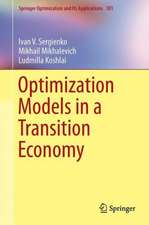Introductory Lectures on Convex Optimization: A Basic Course: Applied Optimization, cartea 87
Autor Y. Nesteroven Limba Engleză Paperback – 10 dec 2013
| Toate formatele și edițiile | Preț | Express |
|---|---|---|
| Paperback (1) | 579.98 lei 38-44 zile | |
| Springer Us – 10 dec 2013 | 579.98 lei 38-44 zile | |
| Hardback (1) | 1112.92 lei 6-8 săpt. | |
| Springer Us – 31 dec 2003 | 1112.92 lei 6-8 săpt. |
Din seria Applied Optimization
-
 Preț: 127.66 lei
Preț: 127.66 lei - 15%
 Preț: 643.34 lei
Preț: 643.34 lei - 18%
 Preț: 1231.47 lei
Preț: 1231.47 lei - 20%
 Preț: 979.71 lei
Preț: 979.71 lei - 15%
 Preț: 638.24 lei
Preț: 638.24 lei - 15%
 Preț: 646.62 lei
Preț: 646.62 lei - 18%
 Preț: 1116.89 lei
Preț: 1116.89 lei - 15%
 Preț: 638.76 lei
Preț: 638.76 lei - 15%
 Preț: 643.84 lei
Preț: 643.84 lei - 15%
 Preț: 640.88 lei
Preț: 640.88 lei - 20%
 Preț: 995.09 lei
Preț: 995.09 lei - 15%
 Preț: 650.37 lei
Preț: 650.37 lei - 18%
 Preț: 1233.69 lei
Preț: 1233.69 lei - 18%
 Preț: 954.14 lei
Preț: 954.14 lei - 18%
 Preț: 1240.79 lei
Preț: 1240.79 lei - 18%
 Preț: 1226.24 lei
Preț: 1226.24 lei - 18%
 Preț: 1235.43 lei
Preț: 1235.43 lei - 18%
 Preț: 1221.51 lei
Preț: 1221.51 lei - 18%
 Preț: 1231.32 lei
Preț: 1231.32 lei - 18%
 Preț: 959.36 lei
Preț: 959.36 lei - 15%
 Preț: 600.26 lei
Preț: 600.26 lei - 15%
 Preț: 654.62 lei
Preț: 654.62 lei - 18%
 Preț: 953.35 lei
Preț: 953.35 lei - 18%
 Preț: 949.23 lei
Preț: 949.23 lei - 15%
 Preț: 642.68 lei
Preț: 642.68 lei - 15%
 Preț: 643.34 lei
Preț: 643.34 lei - 15%
 Preț: 641.71 lei
Preț: 641.71 lei
Preț: 579.98 lei
Preț vechi: 763.13 lei
-24% Nou
Puncte Express: 870
Preț estimativ în valută:
110.98€ • 116.18$ • 91.83£
110.98€ • 116.18$ • 91.83£
Carte tipărită la comandă
Livrare economică 01-07 aprilie
Preluare comenzi: 021 569.72.76
Specificații
ISBN-13: 9781461346913
ISBN-10: 1461346916
Pagini: 260
Dimensiuni: 155 x 235 x 17 mm
Greutate: 0.37 kg
Ediția:Softcover reprint of the original 1st ed. 2004
Editura: Springer Us
Colecția Springer
Seria Applied Optimization
Locul publicării:New York, NY, United States
ISBN-10: 1461346916
Pagini: 260
Dimensiuni: 155 x 235 x 17 mm
Greutate: 0.37 kg
Ediția:Softcover reprint of the original 1st ed. 2004
Editura: Springer Us
Colecția Springer
Seria Applied Optimization
Locul publicării:New York, NY, United States
Public țintă
ResearchDescriere
It
was
in
the
middle
of
the
1980s,
when
the
seminal
paper
by
Kar
markar
opened
a
new
epoch
in
nonlinear
optimization.
The
importance
of
this
paper,
containing
a
new
polynomial-time
algorithm
for
linear
op
timization
problems,
was
not
only
in
its
complexity
bound.
At
that
time,
the
most
surprising
feature
of
this
algorithm
was
that
the
theoretical
pre
diction
of
its
high
efficiency
was
supported
by
excellent
computational
results.
This
unusual
fact
dramatically
changed
the
style
and
direc
tions
of
the
research
in
nonlinear
optimization.
Thereafter
it
became
more
and
more
common
that
the
new
methods
were
provided
with
a
complexity
analysis,
which
was
considered
a
better
justification
of
their
efficiency
than
computational
experiments.
In
a
new
rapidly
develop
ing
field,
which
got
the
name
"polynomial-time
interior-point
methods",
such
a
justification
was
obligatory.
Afteralmost
fifteen
years
of
intensive
research,
the
main
results
of
this
development
started
to
appear
in
monographs
[12,
14,
16,
17,
18,
19].
Approximately
at
that
time
the
author
was
asked
to
prepare
a
new
course
on
nonlinear
optimization
for
graduate
students.
The
idea
was
to
create
a
course
which
would
reflect
the
new
developments
in
the
field.
Actually,
this
was
a
major
challenge.
At
the
time
only
the
theory
of
interior-point
methods
for
linear
optimization
was
polished
enough
to
be
explained
to
students.
The
general
theory
of
self-concordant
functions
had
appeared
in
print
only
once
in
the
form
of
research
monograph
[12].












